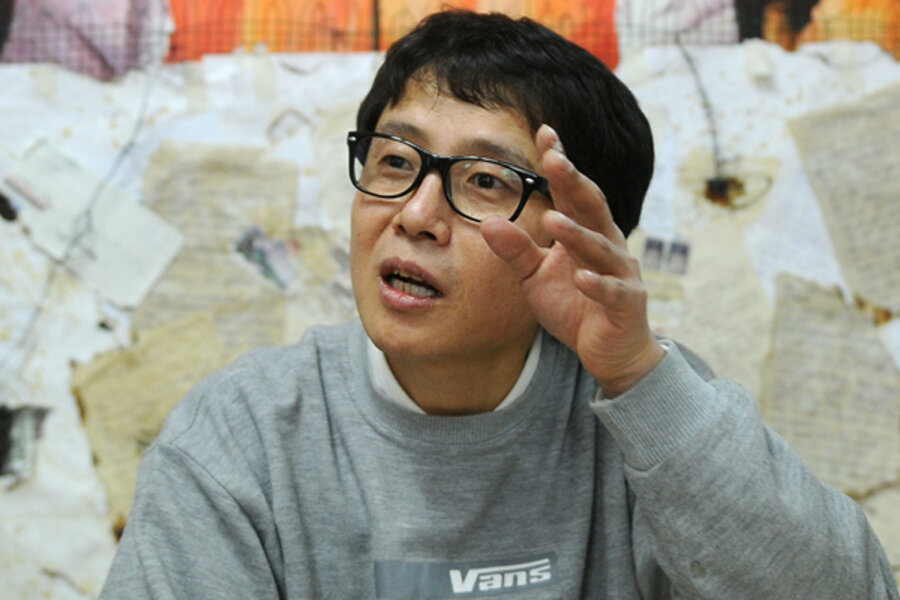Portrait of a North Korean propagandist turned protest artist
Loading...
| Seoul, South Korea
For Song Byeok, as for many North Koreans, getting out of his homeland came at a steep price.
The soft-spoken artist decided to leave in 2000 to find food, as famine ravaged large parts of the country. During his initial attempt to cross the Tumen River into China to find and bring back food, Mr. Song watched as his father was washed away in the surging waters.
“I was about halfway across the river when the rope grew slack,” he says in a recent interview. “My father told me three times to go and leave him and then disappeared underwater.”
Mr. Song dragged himself ashore and begged for help from a group of North Korean border guards. “They refused, saying, ‘Why have you survived? You should die also,’ and they beat me up,” he says.
He spent seven months in a North Korean prison camp, where he lost a finger to frostbite and became disillusioned with the regime. After Song was amnestied, he successfully sneaked into China. A year later, after securing a secret passage to South Korea, he arrived in Seoul.
Song is just one of the estimated tens of thousands of starving or disillusioned North Koreans who have fled the country since the mid-1990s, when a collapse of the country’s food distribution systems coincided with a devastating famine.
Propaganda artist
Before fleeing to China, Song was a propaganda artist. In a rural studio south of the capital, Pyongyang, he created grinning portraits of "Dear Leader" Kim Jong-il and vibrant billboards depicting ranks of revolutionary workers and peasants.
Song started painting as a hobby, but his talents were quickly noticed by the authorities and he was soon recruited to work for the regime.
He says the central authorities would present him with strict models outlining the posters’ style and content. Painting “outside the lines” – making personal alterations to the models – was strictly forbidden. “Every line, every angle, it was all presented in the model. It was just copying. There was no creativity, none of the artist’s personality, nothing.”
At his small studio in suburban Seoul, Song unveils a reproduction of a typical propaganda poster, rendered in an apocalyptic palette of reds and browns. It shows a stern-faced worker clenching his weapon, with shrill yellow Korean script running along the top and bottom of the painting: Are you going to live as a free human, or as a slave? Let’s protect the red flag of the revolution until the very end.
“In North Korea, this is an actual slogan,” Song says. “But it could be turned back at them: Are you going to live as free men or as slaves? Look at how you’re living: You’ve got no freedom of speech or activity or assembly, or anything in North Korea.”
Defector numbers
The northern émigré community in South Korea has since swelled to more than 21,000, and activists estimate as many as 40,000 North Koreans live as refugees in China, procuring food for their relatives or awaiting their chance to escape to the South. Using underground networks of people smugglers and missionary organizations, refugees continue to trickle into the South, most via Southeast Asia, but many are now falling short at the first hurdle – the heavily guarded border between North Korea and China.
Tim Peters, the founder of refugee aid group Helping Hands Korea, says that the recent series of uprisings in the Middle East has led North Korea and China to tighten border controls, fearing any sort of ripple effect on their own societies.
“The Beijing government in general has a very deep-seated fear of any sort of instability,” says Mr. Peters, a Michigan native who first moved to Korea as a young missionary in the mid-1970s.
The Tumen River border, once an easy crossing point for defectors and smugglers, has today been rigged with cameras and heat and motion sensors in a bid to detect any large movement of people, Peters says. At the same time, continuing food shortages and economic mismanagement are pushing increasing numbers to flee.
“The so-called push factors for them to risk everything and leave North Korea are growing, just as the barriers to their exit are being strengthened,” Peters says. “This causes enormous tension.”
Life in limbo
For the tens of thousands of refugees in northeast China – seen by Chinese authorities as “illegal economic migrants” – life remains in a state of limbo. Those caught by Chinese police are routinely arrested and sent back to North Korea, where they face imprisonment and torture. Women are also vulnerable to sex trafficking and abuse, according to experts.
“Whatever happens to them in China … they can’t complain or resist,” says Chun Ki-won, the head of Durihana, a Seoul-based missionary organization that aids refugees. “Basically, they live like beasts.”
Disembarking at Seoul’s futuristic Incheon airport in early 2002, Song marveled at the height of the well-fed South Korean people and the number of cars on the roads. Like many defectors from the North, he says that it was only once he was jailed that he realized just how oppressive his own government was. “In prison, I thought that if I get out, I’m going to South Korea,” he says. “I may die, I may live, but I can’t stay here any longer.”
It’s a sentiment Song is trying to communicate with a new art series, turning the regime’s ubiquitous propaganda imagery back onto itself. One depicts Kim Jong-il in the iconic pose of Marilyn Monroe, holding down his skirt as he steps over an updraft. Like the Hollywood starlet, Song says, the “Dear Leader” is clearly trying to hide something.
“When a person’s born, their first human right is freedom and every individual has their own freedom,” he says. “The only country that doesn’t have any of these things in the whole world is North Korea.”





